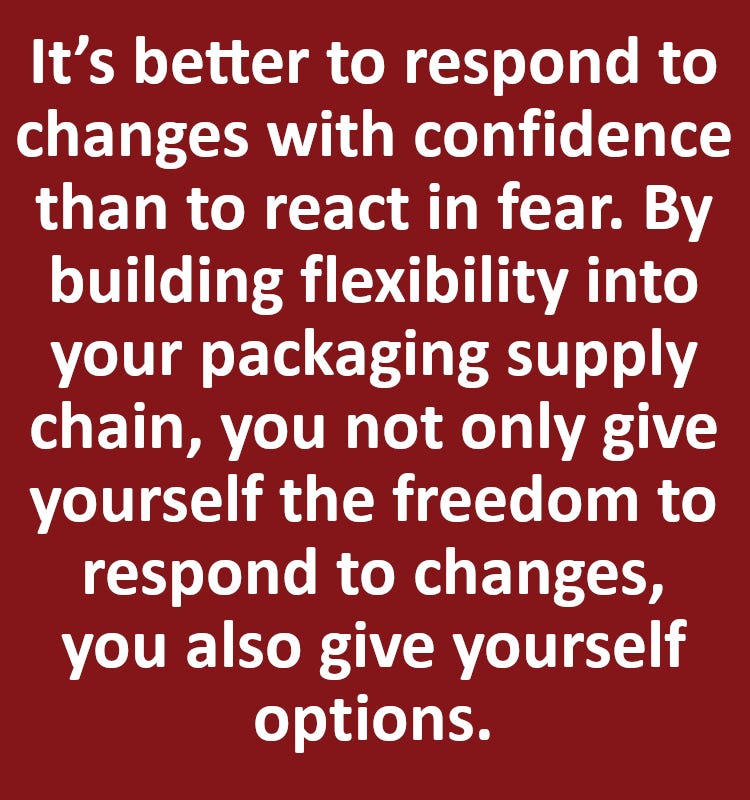The Hidden Risk of Single Sourcing Your Packaging
Supply chain expert John Moran identifies a significant risk of relying on just one supplier for your packaging — then he itemizes a three-step solution.

At first glance, single sourcing sounds like common sense. You can build a good relationship with your one, top supplier over time and be reliant on them. This can bring a lot of benefits, like better trouble management and dispute resolution. A solid, long-term relationship with your packaging supplier is a great foundation for your business.
It’s also a strategy that comes with significant risk.
Recent events such as the US-China trade war and the COVID-19 pandemic have caused massive disruptions in global supply chains. The impact has also been felt in packaging supply. Shutdowns and shipping delays have completely upended established supply networks and have left many buyers scrambling for continuity of supply. And the impact is made much more severe if you are relying on a single source for your packaging.
Single sourcing can put your business at risk in two ways. The first is when a supplier unexpectedly goes offline for whatever reason. This can leave you scrambling to find a new supplier, which can be a big challenge when supply networks are in chaos.
The second way is not so obvious. By relying on a single supplier, you may also be over-relying on informal and undocumented business processes. If that supplier goes offline, it could be difficult to unravel those processes to set up a new supplier.
It can also take a long time to set up the new supplier if your artwork and specs are not properly documented or freely available. And during a lockdown situation where travel is impossible, it may also be impossible to put people on the ground to ensure everything is to spec and your new supplier is performing, even if they’re only in the next state.
This hidden risk is dangerous to your business because it can cause delays at a time when you need to move quickly. And delays in setting up a new supplier can mean an interruption in your continuity of supply. So how do you address this hidden risk?
The solution is to build flexibility into your supply chain. Here are three steps.
Build supply chain flexibility.
Building flexibility into your supply chain ensures you won’t get caught off guard. It removes the hidden risk of single sourcing and gives you options when a crisis occurs.
The goal of building flexibility is to make your supply chain as portable as possible so you can efficiently switch suppliers when your supply is interrupted. To do this, you need to make three key changes to your procurement operations:
1. Identify and document key processes.
Analyze your product categories to see where you’re at risk. Are you relying too much on one supplier for a critical component or process? Do you have local in-person oversight and quality-assurance (QA) monitoring of press runs and production in case of a travel ban?
2. Simplify and consolidate stakeholder communications.
Bring all your stakeholders into a single conversation to ensure information flows are fast and accurate. Consider replacing email and Excel files with online collaboration tools to communicate mission-critical information such as artwork.
3. Move to an online workflow management structure.
Create a central database for your approved and formal specifications and artwork to ensure these critical assets are at your fingertips when you need them. Automate workflows to remove reliance on informal arrangements and enable real-time monitoring and control of key processes.
The bottom line? Have options.
Building in flexibility protects your supply chain from hidden risks. Because your processes are all documented and automated, you can easily switch production to a new supplier when a crisis occurs. And with a strong professional network and online collaboration platform you can ensure that vital functions such as artwork approval and on-site quality control go smoothly without interrupting your continuity of supply.
More importantly, when your supply chain is flexible and secure you have options. You can choose to stay with a single supplier. This lets you enjoy the benefits of a long-term relationship knowing you can quickly change suppliers without interrupting your supply chain. Or you can choose to diversify your supply chain to multiple suppliers knowing that your processes, specs, and artwork will be consistent across your entire supply chain.

Change and disruption is inevitable. It’s better to respond to changes with confidence than to react in fear. By building flexibility into your packaging supply chain, you not only give yourself the freedom to respond to changes, you also give yourself options. So when your competitors are reacting, you’re choosing the right option and going back to business as usual.
About the Author(s)
You May Also Like




